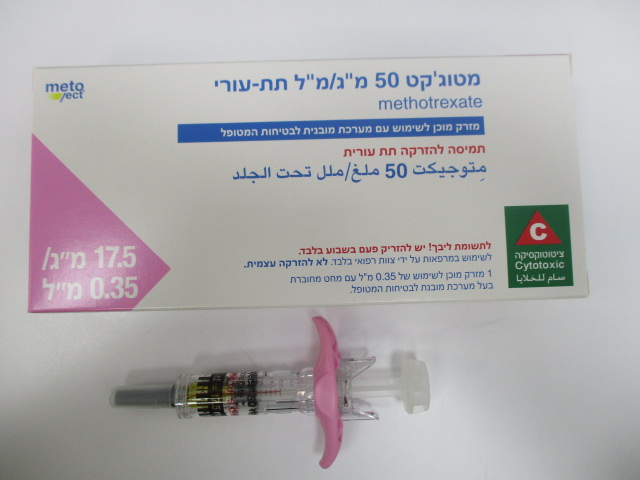Quest for the right Drug

מטוג'קט 50 מ"ג / מ"ל תת עורי METOJECT 50 MG/ML S.C (METHOTREXATE)
תרופה במרשם
תרופה בסל
נרקוטיקה
ציטוטוקסיקה
צורת מתן:
תת-עורי : S.C
צורת מינון:
תמיסה להזרקה : SOLUTION FOR INJECTION
עלון לרופא
מינוניםPosology התוויות
Indications תופעות לוואי
Adverse reactions התוויות נגד
Contraindications אינטראקציות
Interactions מינון יתר
Overdose הריון/הנקה
Pregnancy & Lactation אוכלוסיות מיוחדות
Special populations תכונות פרמקולוגיות
Pharmacological properties מידע רוקחי
Pharmaceutical particulars אזהרת שימוש
Special Warning עלון לרופא
Physicians Leaflet
Pregnancy & Lactation : הריון/הנקה
4.6 Fertility, pregnancy and lactation Women of childbearing potential/Contraception in females Women must not get pregnant during methotrexate therapy, and effective contraception must be used during treatment with methotrexate and at least 6 months thereafter (see section 4.4). Prior to initiating therapy, women of childbearing potential must be informed of the risk of malformations associated with methotrexate and any existing pregnancy must be excluded with certainty by taking appropriate measures, e.g. a pregnancy test. During treatment pregnancy tests should be repeated as clinically required (e.g. after any gap of contraception). Female patients of reproductive potential must be counselled regarding pregnancy prevention and planning. Contraception in males It is not known if methotrexate is present in semen. Methotrexate has been shown to be genotoxic in animal studies, such that the risk of genotoxic effects on sperm cells cannot completely be excluded. Limited clinical evidence does not indicate an increased risk of malformations or miscarriage following paternal exposure to low-dose methotrexate (less than 30 mg/week). For higher doses, there is insufficient data to estimate the risks of malformations or miscarriage following paternal exposure. As precautionary measures, sexually active male patients or their female partners are recommended to use reliable contraception during treatment of the male patient and for at least 3 months after cessation of methotrexate. Men should not donate semen during therapy or for 3 months following discontinuation of methotrexate. Pregnancy Methotrexate is contraindicated during pregnancy in non-oncological indications (see section 4.3). If pregnancy occurs during treatment with methotrexate and up to six months thereafter, medical advice should be given regarding the risk of harmful effects on the child associated with treatment and ultrasonography examinations should be performed to confirm normal foetal development. In animal studies, methotrexate has shown reproductive toxicity, especially during the first trimester (see section 5.3). Methotrexate has been shown to be teratogenic to humans; it has been reported to cause foetal death, miscarriages and/or congenital abnormalities (e.g. craniofacial, cardiovascular, central nervous system and extremity-related). Methotrexate is a powerful human teratogen, with an increased risk of spontaneous abortions, intrauterine growth restriction and congenital malformations in case of exposure during pregnancy. Spontaneous abortions have been reported in 42.5% of pregnant women exposed to low-dose methotrexate treatment (less than 30 mg/week), compared to a reported rate of 22.5% in disease-matched patients treated with drugs other than methotrexate. Major birth defects occurred in 6.6% of live births in women exposed to low-dose methotrexate treatment (less than 30 mg/week) during pregnancy, compared to approximately 4% of live births in disease- matched patients treated with drugs other than methotrexate. Insufficient data is available for methotrexate exposure during pregnancy higher than 30 mg/week, but higher rates of spontaneous abortions and congenital malformations are expected. When methotrexate was discontinued prior to conception, normal pregnancies have been reported. Breast-feeding Methotrexate is excreted in human milk. Because of the potential for serious adverse reactions in breast- fed infants, Metoject is contraindicated during breast-feeding (see section 4.3). Therefore breast-feeding must be discontinued prior to and throughout administration. Fertility Methotrexate affects spermatogenesis and oogenesis and may decrease fertility. In humans, methotrexate has been reported to cause oligospermia, menstrual dysfunction and amenorrhoea. These effects appear to be reversible after discontinuation of therapy in most cases.

שימוש לפי פנקס קופ''ח כללית 1994
Leukemias, non-hodgkin's lymphomas, breast, head and lung carcinoma, choriocarcinoma, osteogenic sarcoma. Severe psoriasis, rheumatoid arthritis unresponsive to conventional therapy, mycosis fungoides
תאריך הכללה מקורי בסל
01/01/1995
הגבלות
תרופה שאושרה לשימוש כללי בקופ'ח
מידע נוסף
עלון מידע לצרכן
06.12.20 - עלון לצרכן אנגלית 06.12.20 - עלון לצרכן עברית 06.12.20 - עלון לצרכן ערבית 07.06.23 - עלון לצרכן אנגלית 04.04.23 - עלון לצרכן עברית 07.06.23 - עלון לצרכן ערבית 30.03.24 - עלון לצרכן עברית 05.06.24 - עלון לצרכן אנגלית 05.06.24 - עלון לצרכן ערבית 06.11.24 - עלון לצרכן עברית 24.07.14 - החמרה לעלון 09.10.18 - החמרה לעלון 19.07.20 - החמרה לעלון 25.05.17 - החמרה לעלון 04.04.23 - החמרה לעלון 30.03.24 - החמרה לעלון 06.11.24 - החמרה לעלוןלתרופה במאגר משרד הבריאות
מטוג'קט 50 מ"ג / מ"ל תת עורי